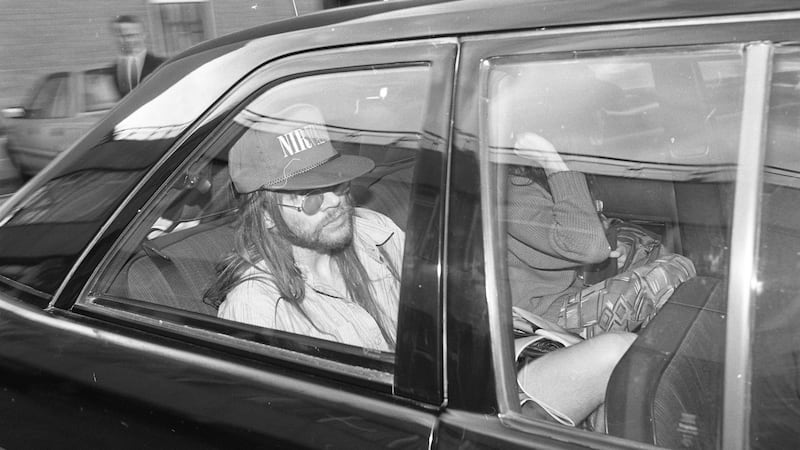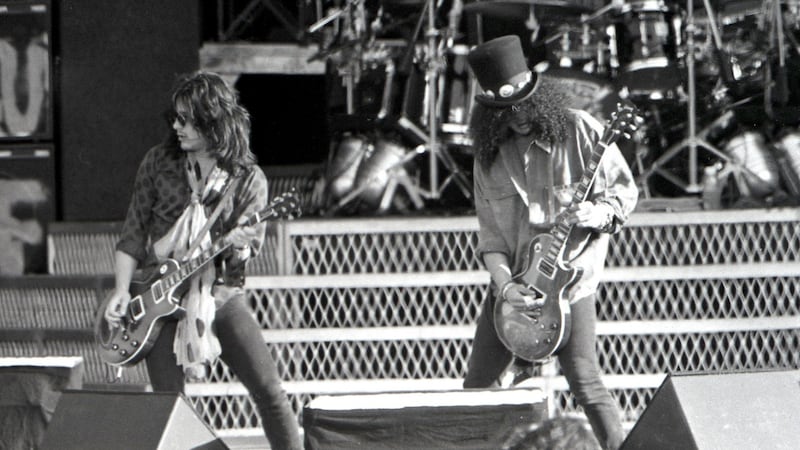Twenty-five years ago, Guns N’ Roses were the biggest band in the world. The musicians – waifs and strays who had emerged from the scuzzy Los Angeles hard rock scene – had conquered the planet musically in the previous five years.
But by 1992 they were falling apart.
Their brilliant debut album Appetite for Destruction, released in 1987, took a year to reach the top of the Billboard 200, propelled there by the constant rotation on MTV of the videos for Paradise City and Sweet Child O' Mine. It would go on to become the bestselling debut album of all time.
The follow-up double album, Use Your Illusion I and II, released in September 1991, was a protracted affair far removed from their incendiary debut. It was "ridiculously self-indulgent", confessed lead guitarist Slash many years later, the sound of a band trying too hard to recreate the sound and sense of desperation which had made them special.
Nevertheless, it sold millions of records, at a time when sales were still measured in hard sales.

In May 1992, Guns N’ Roses arrived in Ireland at the start of their European tour on Saturday 16th. They came trailing a reputation for unpredictability. The “most dangerous band in the world” tag was not just record company hype.
Crushed to death
At Donington Park in Britain in 1988, two fans had been crushed to death during the band’s set; in 1991 singer Axl Rose had stopped a show in St Louis when he had discovered a fan was filming the show. Fans had wrecked the venue; Rose had been charged with inciting the riot.
A year later fans had trashed an arena in Montreal, after Rose again stormed off stage.
Trouble followed Guns N’ Roses wherever they went. Rose’s habitual lateness for every concert tried the patience of fans, and the band racked up huge fines from promoters. When they did go on stage, the ever combustible Rose was capable of anything. They were unpredictable and exhilarating and almost constantly drunk, stoned or both.
At Wembley, a month before they arrived in Ireland, bass player Duff McKagan was so drunk during a tribute concert to the late Freddie Mercury, who had died the previous year, that he had to be carried on to the stage by Elton John.
The concert at Slane had personal resonances for McKagan. His maternal grandfather Jon Harrington was from Co Cork. McKagan was the first of his eight siblings to visit Ireland.
A reception committee of his Irish relatives was on hand, 100 people who hosted a barbecue in his honour. It was preceded by a pub crawl in which his cousins tried to match the man whose gargantuan appetite for booze had earned him the moniker “Duff, the king of beers”.
McKagan knew he was in trouble when he realised he could drink more than his Irish relatives.
"I was around a bunch of Irish relatives who were drinking a ton and then this old gal, a relative, grabbed me by the cheeks and said 'you're drinking too much'," Duff told The Irish Times six years ago.
“I looked around. All these f***ers were drinking. I drink too much compared to these folks? Really?”
Half a gallon
Duff was drinking a half a gallon of vodka a day; at that stage Slash too was drinking heavily and ingesting vast quantities of cocaine, heroin and crack.
Slash's verdict on Slane? He told Hot Press years later: "I remember the place, but not the performance, which is indicative of how blurred my life had become."
The culture of excess extended to every aspect of this now-infamous tour. The band didn’t even have suitcases until their record company Geffen bought them some with their first advance.
In a few short years they had gone from travelling in a transit van to a custom-fitted Boeing 727 borrowed for this tour from the MGM casino in Las Vegas. Slash and McKagan began by smoking crack in the toilet before it had even left the ground in Los Angeles.
As they watched the smoke curl up an air vent, McKagan recalled saying to himself: “Of course we can smoke on here, it’s our plane.”

By the time of the Use Your Illusion tour, two original members of the band, guitarist Izzy Stradlin and drummer Steven Adler, were no longer with Gun N’ Roses. Adler had been fired in 1990 over heroin addiction (being sacked for excessive consumption was a singular feat within the band). After attaining sobriety, Stradlin had left in 1991, later saying he was sick of the band’s antics.
Guns N’ Roses now had a horn section, a keyboard player and backing singers, as Rose pursued his vision of turning Guns N’ Roses into a hard-rock version of Elton John.
In the music industry at that time, live tours were staged in order to sell albums (now it’s the other way around), and for a band as big as Guns N’ Roses money was no object.
Every night the band hosted themed parties: based on Roman baths, a Mexican fiesta and horror films. Even the band, incorrigible partygoers that they were, grew bored by them.
Hired yachts
They booked out restaurants and hired yachts. They went snorkelling in the Great Barrier Reef and booked out a bowling alley in London.
Occasionally, Slash would ask himself who was footing the bill, but would think twice lest he disturb the already-delicate atmosphere.
The answer was that he and the other witless band members were paying for it themselves. Despite playing to seven million people over two and a half years, the tour barely broke even.
McKagan was so shocked by the profligacy that when he got sober later after a near-death experience, he went to business school and founded a wealth management firm.
At Slane, Guns N’ Roses were supported by My Little Funhouse and Faith No More. Slash, Duff McKagan and drummer Matt Sorum arrived early by helicopter and went fishing in the River Boyne behind the stage.
Rose was still in his hotel room in the Conrad Hotel in central Dublin. There was nothing unusual about this. At that stage his semi-detached relationship with the rest of the band was entrenched.
Time ticked on. The restive audience started making human pyramids, the top body mooning to an appreciative audience. Compared with the atmosphere of menace in other venues – one German promoter locked the band into the arena fearing a riot – it was all very good-humoured.
But Slane Castle owner Lord Henry Mountcharles was worried. The band were supposed to be on stage. Where was Axl Rose? Slash didn't know and pointed Mountcharles in the direction of the band's manager Doug Goldstein, who was blithely fishing in the Boyne.
Rose was still in his hotel room in Dublin when he was supposed to have been on stage. (At least he could be found. In Stockholm he had been spotted watching a fireworks display as the band searched frantically for him.)
No apology
He was taken by helicopter from Dublin to Slane. Eventually the band went on stage two hours after the appointed time without an apology. It was growing cold by then.
Denis Desmond of MCD was the promoter – and is again for this year’s Slane concert. He admits there was a “a couple of anxious moments” in 1992. “Those were the days before mobile phones. We had to find a pay phone to call the hotel reception.”
Rose was taken from the hotel by limousine to Dublin Airport, and to Slane by Sikorsky helicopter. He did turn up late, but not the often reported two hours late, says Desmond.
“Believe me, he’s been later,” says Desmond, referring to a 2010 concert in the O2 venue, which ended in farce after Axl Rose stormed off stage.
Was it worth the wait in 1992? “When they went on stage, they really turned it on,” said Henry Mountcharles, recalling the gig this year.

Reviewing the concert in The Irish Times the next day, critic Dave Fanning was a little less complimentary.
“Guns N’ Roses gave everything they had but the problem is that with only two or three albums on release they don’t really have a lot. They’re just a very famous hard rock band who have five or six fine songs.”
Ironically, given what we know now, he wrote that Axl Rose had “worked the stage like a true professional”, but said that a long drum solo had been “ludicrous” and that Guns N’ Roses would “have to do better to make it on musical merits”.
And the cracks were evident. Presciently, Fanning mused that the band were “in danger of becoming just another hard-noise outfit on Rock’s lost highway . . . 1992 may be seen in years to come as a period of transition for Guns N’ Roses.”
Incendiary brilliance
If you want to make up your own mind about the gig, there is a shaky but watchable video is on YouTube. Surprisingly, in the days before smartphones, somebody filmed the whole concert.
Guns N’ Roses had blown all the lipstick-pouting, spandex-wearing hair-metal bands away with their incendiary brilliance, but in 1993, they in turn flamed out. The original incarnation of the band quit and Guns N’ Roses faded away. Their brand of hard rock excess was replaced by the plaid-wearing, morose cheerlessness of grunge.
We may never see their likes again, but we thought the same thing in 1992, and now they are back. Some 80,000 tickets sold out within one day last December for the band’s return to Slane Castle this weekend.
Core members Axl Rose, Slash, Duff McKagan, and Dizzy Reed will take to the stage, alongside guitarist Richard Fortus, drummer Frank Ferrer, and keyboardist Melissa Reese.
Fans are advised to get there early. Axl apparently turns up on time these days. “They’ve done 100 shows plus on this tour and have turned up on time every time,” says Denis Desmond.












